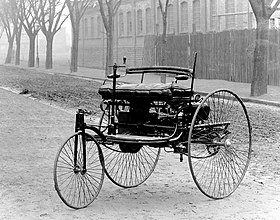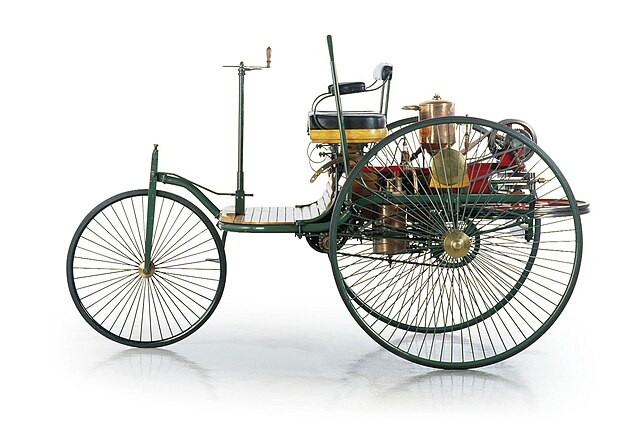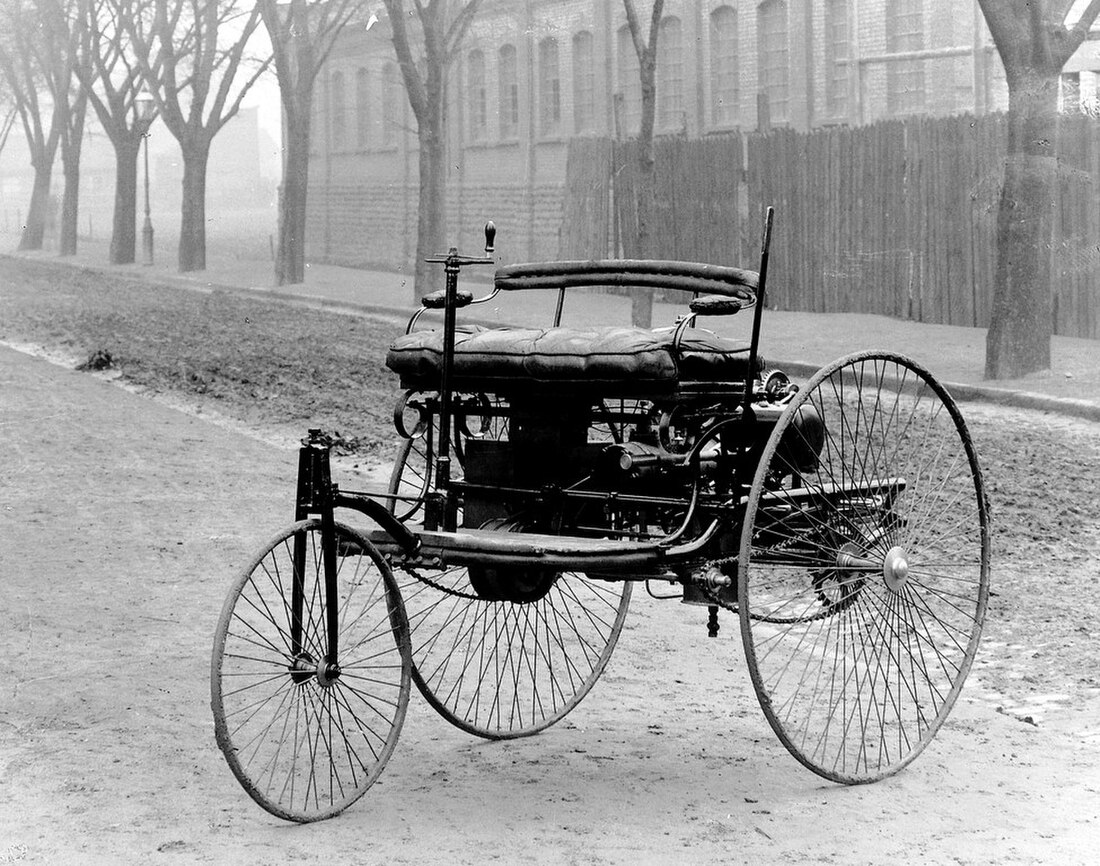Benz Patent-Motorwagen
First modern automobile From Wikipedia, the free encyclopedia
The Benz Patent-Motorwagen ("patent motorcar"), built in 1885 by the German engineer Karl Benz, is widely regarded as the first practical automobile[1][a] and was the first car put into production.[8] It was patented in January 1886 and unveiled in public later that year. The original cost of the vehicle was 600 imperial German marks,[9] approximately 150 US dollars (equivalent to $5,200 in 2024).
| Benz Patent-Motorwagen | |
|---|---|
 Benz Patent-Motorwagen Nr. 1 | |
| Overview | |
| Manufacturer | Rheinische Gasmotorenfabrik Benz & Cie. (known today as Mercedes-Benz) |
| Production | 1886–1893 |
| Body and chassis | |
| Layout | Rear Engine, RWD |
| Powertrain | |
| Engine | 1.0 L (954 cc) single cylinder engine (Ligroin fuel) |
| Power output | 2⁄3 brake horsepower (0.68 PS; 0.50 kW) @ 400 rpm 4⁄5 newton-metre (0.59 lb⋅ft) |
| Transmission | Single-Speed Belt Drive |
| Dimensions | |
| Wheelbase | 57.1 inches (1,450 mm) |
| Length | 106.3 inches (2,700 mm) |
| Width | 55.1 inches (1,400 mm) |
| Height | 57.1 inches (1,450 mm) |
| Curb weight | 600 pounds (270 kg) |
| Chronology | |
| Successor | Benz Velo |
Two years after Karl Benz drove the car in public in July 1886,[10] Karl's wife Bertha demonstrated its feasibility in a trip from Mannheim to Pforzheim in August 1888. Around the same time, the Patent-Motorwagen became the first commercially available automobile in history.[11] Émile Roger, who made Benz engines under license in France, was one of the first persons to buy Benz' car; from 1888, Roger was also the salesperson of the Benz Patent-Motorwagen in France, selling one to Émile Levassor in 1888.[12][13] The Patent-Motorwagen was shown at an exhibition in Munich in 1888, winning a gold medal, and at the 1889 Paris Exposition.[13]
Due to the creation of the Patent-Motorwagen, Karl Benz has been hailed as the father and inventor of the automobile.[1][14][15]
Development, specifications and Karl Benz's first drive
Summarize
Perspective


After developing a successful gasoline-powered two-stroke piston engine in 1873, Benz focused on developing a motorized vehicle while maintaining a career as a designer and manufacturer of stationary engines and their associated parts.
The Benz Patent-Motorwagen was a motor tricycle with a rear-mounted engine. The vehicle contained many new inventions. It was constructed of steel tubing with woodwork panels. The steel-spoked wheels and solid rubber tires were Benz's own design. Steering was by way of a toothed rack that pivoted the unsprung front wheel. Fully elliptic springs were used at the back along with a beam axle and chain drive on both sides. A simple belt system served as a single-speed transmission, varying torque between an open disc and drive disc.
The first Motorwagen used the Benz 954 cc (58.2 cu in) single-cylinder four-stroke engine with trembler coil ignition.[16] This new engine produced 500 watts (2⁄3 hp) at 250 rpm in the Patent-Motorwagen, although later tests by the University of Mannheim showed it to be capable of 670 W (0.9 hp) at 400 rpm. It was an extremely light engine for the time, weighing about 100 kg (220 lb). Although its open crankcase and drip oiling system would be alien to a modern mechanic, its use of a pushrod-operated poppet valve for exhaust would be quite familiar. A large horizontal flywheel stabilized the single-cylinder engine's power output. An evaporative carburettor was controlled by a sleeve valve to regulate power and engine speed. The first model of the Motorwagen had not been built with a carburettor, rather a basin of fuel soaked fibers that supplied fuel to the cylinder by evaporation.[citation needed]
The vehicle was awarded the German patent number 37435, for which Karl Benz applied on 29 January 1886. Following official procedures, the date of the application became the patent date for the invention once the patent was granted, which occurred in November of that year. Benz unveiled his invention to the public on 3 July 1886, on the Ringstrasse in Mannheim. For the first time Karl Benz publicly drove the car on July 3, 1886, in Mannheim at a top speed of 16 km/h (10 mph).[10]
Benz later made more models of the Motorwagen: model number 2 had 1.1 kW (1.5 hp) engine, and model number 3 had 1.5 kW (2 hp) engine, allowing the vehicle to reach a maximum speed of approximately 16 km/h (10 mph). The chassis was improved in 1887 with the introduction of wooden-spoke wheels, a fuel tank, and a manual leather shoe brake on the rear wheels.[citation needed]
About 25 Patent-Motorwagen were built between 1886 and 1894.[17]
Bertha Benz's trip
Bertha Benz, Karl's wife, whose dowry was said to have made a portion of contribution to finance the development of the Patent-Motorwagen,[18] was aware of the need for publicity. She took the Patent-Motorwagen No. 3 and drove it on the first long-distance internal combustion automobile road trip to demonstrate its feasibility. That trip occurred in early August 1888, when she took her sons Eugen and Richard, fifteen and fourteen years old, respectively, on a ride from Mannheim through Heidelberg, and Wiesloch, to her maternal hometown of Pforzheim.[19]

In Germany, a parade of antique automobiles celebrates this historic trip of Bertha Benz every two years. On February 25, 2008, the Bertha Benz Memorial Route,[20] following the route of Benz's journey, was officially approved as a Tourist or Scenic Route by the German authorities as a route of industrial heritage of mankind. The 194 km (121 mi) of signposted route leads from Mannheim via Heidelberg to Pforzheim (Black Forest) and back.
See also
- History of the automobile
- Benz Velo (later 4 wheel model)
- List of Mercedes-Benz vehicles (incl. summary of Benz vehicles)
- List of motorcycles of the 1890s
- List of motorized trikes
- Three-wheeler
Notes
- Before Karl Benz patented his Motorwagen in January 1886, several inventors were working on automobiles powered by steam engines; in 1769, Nicolas-Joseph Cugnot built the first steam-propelled vehicle.[2] During the 1870s, Bollée created several steam vehicles which could carry passengers for road trips.[3] Steam cars have, however, been characterized by various authors as "distinctly uncommercial",[1] "unsafe",[4] and "difficult to manage".[5] According to automotive historian G. N. Georgano, the stationary Otto engine helped make the invention of the Benz Motorwagen possible, which he labelled as "the first motorcar" due to its commercial production.[6] The company Mercedes-Benz also acknowledge there were forerunners to the Motorwagen, but also state that Benz was the first to develop "a 'horseless carriage' into a product for everyday use, which he then brought to market and as a result made his idea useful for the entire world".[7]
References
External links
Wikiwand - on
Seamless Wikipedia browsing. On steroids.
